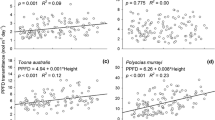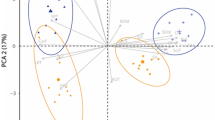Abstract
In tropical seasonal semideciduous forests (TSSF), plants face alternating drought or light shortage in dry and rainy seasons, respectively. To understand how emergent trees deal with seasonality across ontogeny, we sampled all individuals of the widely distributed species Astronium graveolens Jacq. (Anacardiaceae) in 100 random plots (10 m × 10 m each) in a TSSF fragment in southeastern Brazil, and conducted greenhouse experiments on photosynthetic and gas exchange responses to drought and shade. We recognized six ontogenetic stages by external structures, and analyzed height-diameter allometry and biomechanical design across ontogeny. Trade-offs were inferred in early life (increasing height, diameter, or leaf number implied smaller leaves; height growth implied less leaf production) and in mid-life (height or diameter growth implied no branch production). The population did not adjust to a biomechanical model, implying a growth pathway between pioneer and canopy species. All stages were biomechanically stable, and the safety factor decreased with height. In adult trees, the asymptotic height indicated water limitation. In young plants, drought did not affect gas exchange. Light–shadow experiments suggested a trade-off between shoot and root growth. Our results indicate how a light-demanding emergent tree balances trade-offs across ontogeny to deal with seasonally alternating water or light shortage.





Similar content being viewed by others
References
Alvares CA, Stape JL, Sentelhas PC, de Moraes G, Leonardo J, Sparovek G (2013) Köppen’s climate classification map for Brazil. Meteorol Z 22:711–728
Bianchini E, Garcia CC, Pimenta JA, Torezan JMD (2010) Slope variation and population structure of tree species from different ecological groups in South Brazil. Anais da Academia Brasileira de Ciências 82:643–652
Brodribb TJ (2009) Xylem hydraulic physiology: the functional backbone of terrestrial plant productivity. Plant Sci 177:245–251
Brodribb TJ, Holbrook NM (2003) Changes in leaf hydraulic conductance during leaf shedding in seasonally dry tropical forest. New Phytol 158:295–303
Bullock SH (2000) Developmental patterns of tree dimensions in a Neotropical Deciduous Forest. Biotropica 32:42–52
Carvalho PER (2006) Espécies arbóreas brasileiras, vol 1. Embrapa Florestas, Colombo
CEPAGRI (2014) Centro de Pesquisas Metereológicas e Climáticas Aplicadas a Agricultura. URL http://www.cpa.unicamp.br/outras-informacoes/clima-de-campinas.html. 2014
Cielo-Filho R, Gneri MA, Martins FR (2007) Position on slope, disturbance, and tree species coexistence in a seasonal semideciduous forest in SE Brazil. Plant Ecol 190:189–203
Dean T, Long JN (1986) Validity of constant-stress and elastic instability principles of stem formation in Pinus contorta and Trifolium pratense. Ann Bot 58:833–840
Feldpausch TR et al (2012) Tree height integrated into pan-tropical forest biomass estimates. Biogeosciences 9:2567–2622 (Discussion)
Gandolfi S, Joly CA, Leitão Filho HDF (2009) “Gaps of deciduousness”: cyclical gaps in tropical forests. Sci Agric 66:280–284
Gatsuk LE, Smirnova OV, Vorontzova LI, Zaugolnova LB, Zhukova LA (1980) Age states of plants of various growth forms: a review. J Ecol 68:675–696
Grime J (1977) Evidence for the existence of three primary strategies in plants and its relevance to ecological and evolutionary theory. Am Nat 111:1169–1194
Guzmán Q, Antonio J, Cordero S, Roberto A (2013) Growth and photosynthetic performance of five tree seedlings species in response to natural light regimes from the Central Pacific of Costa Rica. Rev Biol Trop 61:1433–1444
Hacke UG, Sperry JS, Pockman WT, Davis SD, McCulloh KA (2001) Trends in wood density and structure are linked to prevention of xylem implosion by negative pressure. Oecologia 126:457–461
Hallé F, Oldeman RAA, Tomlinson PB (1978) Tropical trees and forests: An architectural analysis. Springer, New York
Harper JL (1977) Population biology of plants. Academic Press, London
Henry HAL, Aarssen LW (1999) The interpretation of stem diameter-height allometry in trees: biomechanical constraints, neighbor effects, or biased regressions? Ecol Lett 2:89–97
Hernandes JL, Pedro Júnior MJ, Bardin L (2004) Variação estacional na radiação solar em ambiente externo e no interior de floresta semidecídua. Rev Árvore 22:167–172
Ho MD, Rosas JC, Brown KM, Lynch JP (2005) Root architectural tradeoffs for water and phosphorus acquisition. Funct Plant Biol 32:737–748
Iida Y, Kohyama TS, Kubo T, Kassim AR, Poorter L, Sterck F, Potts MD (2011) Tree architecture and life-history strategies across 200 co-occurring tropical tree species. Funct Ecol 25:1260–1268
Iqbal RM, Rao AR, Rasul E, Wahid A (1997) Mathematical models and response functions in photosynthesis: an exponencial model. In: Pessaraki M (ed) Handbook of photosynthesis. Marcel Dekker Press Inc, New York, pp 803–810
King D (1981) Tree dimensions: maximizing the rate of height growth in dense stands. Oecologia 51:351–356
King DA (1986) Tree form, height growth, and susceptibility to wind damage in Acer saccharum. Ecology 67:980–990
King DA (1996) Allometry and life history of tropical trees. J Trop Ecol 12:25–44
Kitajima K, Mulkey SS, Wright SJ (2005) Variation in crown light utilization characteristics among tropical canopy trees. Ann Bot 95:535–547
Kleiman D, Aarssen LW (2007) The leaf size/number trade-off in trees. J Ecol 95:376–382
Laanisto L, Niinemets Ü (2015) Polytolerance to abiotic stresses: how universal is the shade–drought tolerance trade-off in woody species? Glob Ecol Biogeogr 24:571–580
Marín WA, Flores EM (2002) Astronium graveolens Jacq. In: Vozzo JA (ed) Tropical tree—seed manual. United States Department of Agriculture—Forest Service, Washington, DC, pp 311–314
McMahon T (1973) Size and shape in biology. Science 179:1201–1204
Millet J (2012) L’architecture des arbres des régions tempérées: son histoire, ses concepts, ses usages. Les Éditions MultiMondes, Québec
Niklas KJ (1993) The scaling of plant height: a comparison among major plant clades and anatomical grades. Ann Bot 72:165–172
Niklas KJ (1994a) The allometry of safety-factors for plant height. Am J Bot 81:345–351
Niklas KJ (1994b) Plant allometry—the scaling of form and process. The University of Chicago Press, Chicago
Norberg RA (1988) Theory of growth geometry of plants and self-thinning of plant populations: geometric similarity, elastic similarity, and different growth modes of plant parts. Am Nat 131:220–256
Poorter L, Markesteijn L (2008) Seedling traits determine drought tolerance of tropical tree species. Biotropica 40:321–331
Poorter L, Rozendaal DMA (2008) Leaf size and lead display of thirty-eight tropical tree species. Oecologia 158:35–46
Poorter L, Bongers L, Bongers F (2006) Architecture of 54 moist-forest tree species: traits, trade-offs, and functional groups. Ecology 87:1289–1301
R Core Team (2014) R: a language and environment for statistical computing. R Foundation for Statistical Computing, Vienna
Ryan MG, Yoder BJ (1997) Hydraulic limits to tree height and tree growth. Bioscience 47:235–242
Santos CM, Longui EL, Romeiro D, Zanatto ACS, Morais E, Zanata M, Florsheim SMB (2011) A densidade básica e característica anatômicas variam radialmente na madeira de Astronium graveolens Jacq. (Anacardiaceae). Revista do Instituto Florestal 23:191–201
Silva-Luz CL, Pirani JR (2011) Anacardiaceae—Lista de Espécies da Flora do Brasil. Jardim Botânico do Rio de Janeiro. http://floradobrasil.jbrj.gov.br/
Silveira AP, Martins FR, Araújo FS (2012) Are tree ontogenetic structure and allometric relationship independent of vegetation formation type? A case study with Cordia oncocalyxin the Brazilian caatinga. Acta Oecol 43:126–133
Smirnova O, Palenova M, Komarov A (2002) Ontogeny of different life forms of plants and specific features of age and spatial structure of their populations. Russ J Dev Biol 33:1–10
Smith T, Huston M (1989) A theory of the spatial and temporal dynamics of plant communities. Vegetatio 83:49–69
Sposito TC, Santos FAM (2001) Scaling of stem and crown in eight Cecropia (Cecropiaceae) species of Brazil. Am J Bot 88:939–949
Tyree MT, Sperry JS (1989) Vulnerability of xylem to cavitation and embolism. Annu Rev Plant Biol 40:19–38
Tyree MT, Engelbrecht BMJ, Vargas G, Kursar TA (2003) Desiccation tolerance of five tropical seedlings in Panama. Relationship to a field assessment of drought performance. Plant Physiol 132:1439–1447
van Gelder HA, Poorter L, Sterck FJ (2006) Wood mechanics, allometry, and life-history variation in a tropical rain forest tree community. New Phytol 171:367–378
Veloso HP, Rangel Filho ALR, Lima JCA (1991) Classificação da vegetação brasileira, adaptada a um sistema universal. IBGE, Departamento de Recursos Naturais e Estudos Ambientais, Rio de Janeiro
Walsh RPD (1996) Drought frequency changes in Sabah and adjacent parts of northern Borneo since the late nineteenth century and possible implications for tropical rain forest dynamics. J Trop Ecol 12:385–407
Warton DI, Wright IJ, Falster DS, Westoby M (2006) Bivariate line-fitting methods for allometry. Biol Rev 81:291
Warton D, Duursma R, Falster D, Taskinen S (2011) smatr: (Standardised) Major Axis Estimation and Testing Routines. R package version 3.2.4. http://CRAN.R-project.org/package=smatr,
Zhukova LA, Glotov NV (2001) Morphological polyvariance of ontogeny in natural plant populations. Translated from Ontogenez 32:455–461
Author information
Authors and Affiliations
Corresponding author
Rights and permissions
About this article
Cite this article
de Campos Franci, L., Pereira, L., Machado, R.S. et al. Strategies of a light-demanding emergent tree to thrive in a neotropical seasonal forest with alternating light or water shortage. Braz. J. Bot 39, 207–218 (2016). https://doi.org/10.1007/s40415-015-0211-5
Received:
Accepted:
Published:
Issue Date:
DOI: https://doi.org/10.1007/s40415-015-0211-5




